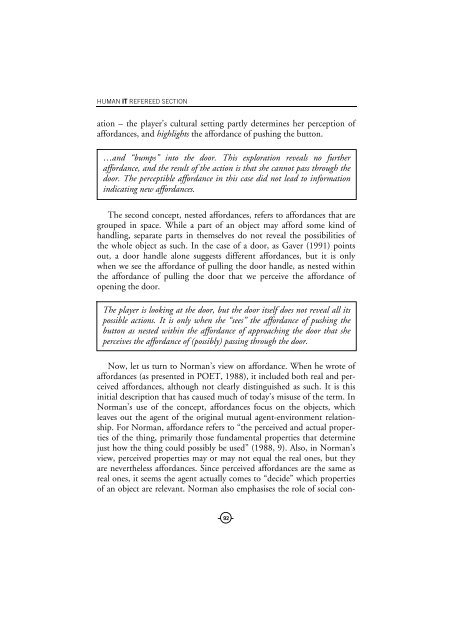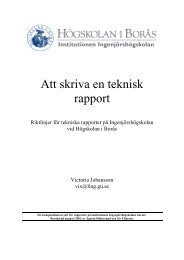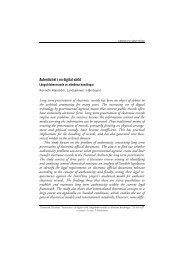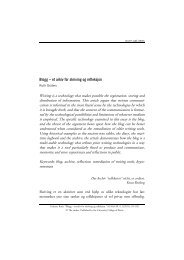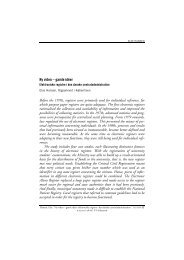The Challenge of Managing Affordances in Computer Game Play
The Challenge of Managing Affordances in Computer Game Play
The Challenge of Managing Affordances in Computer Game Play
You also want an ePaper? Increase the reach of your titles
YUMPU automatically turns print PDFs into web optimized ePapers that Google loves.
HUMAN IT REFEREED SECTION<br />
ation – the player’s cultural sett<strong>in</strong>g partly determ<strong>in</strong>es her perception <strong>of</strong><br />
affordances, and highlights the affordance <strong>of</strong> push<strong>in</strong>g the button.<br />
…and “bumps” <strong>in</strong>to the door. This exploration reveals no further<br />
affordance, and the result <strong>of</strong> the action is that she cannot pass through the<br />
door. <strong>The</strong> perceptible affordance <strong>in</strong> this case did not lead to <strong>in</strong>formation<br />
<strong>in</strong>dicat<strong>in</strong>g new affordances.<br />
<strong>The</strong> second concept, nested affordances, refers to affordances that are<br />
grouped <strong>in</strong> space. While a part <strong>of</strong> an object may afford some k<strong>in</strong>d <strong>of</strong><br />
handl<strong>in</strong>g, separate parts <strong>in</strong> themselves do not reveal the possibilities <strong>of</strong><br />
the whole object as such. In the case <strong>of</strong> a door, as Gaver (1991) po<strong>in</strong>ts<br />
out, a door handle alone suggests different affordances, but it is only<br />
when we see the affordance <strong>of</strong> pull<strong>in</strong>g the door handle, as nested with<strong>in</strong><br />
the affordance <strong>of</strong> pull<strong>in</strong>g the door that we perceive the affordance <strong>of</strong><br />
open<strong>in</strong>g the door.<br />
<strong>The</strong> player is look<strong>in</strong>g at the door, but the door itself does not reveal all its<br />
possible actions. It is only when she “sees” the affordance <strong>of</strong> push<strong>in</strong>g the<br />
button as nested with<strong>in</strong> the affordance <strong>of</strong> approach<strong>in</strong>g the door that she<br />
perceives the affordance <strong>of</strong> (possibly) pass<strong>in</strong>g through the door.<br />
Now, let us turn to Norman’s view on affordance. When he wrote <strong>of</strong><br />
affordances (as presented <strong>in</strong> POET, 1988), it <strong>in</strong>cluded both real and perceived<br />
affordances, although not clearly dist<strong>in</strong>guished as such. It is this<br />
<strong>in</strong>itial description that has caused much <strong>of</strong> today’s misuse <strong>of</strong> the term. In<br />
Norman’s use <strong>of</strong> the concept, affordances focus on the objects, which<br />
leaves out the agent <strong>of</strong> the orig<strong>in</strong>al mutual agent-environment relationship.<br />
For Norman, affordance refers to “the perceived and actual properties<br />
<strong>of</strong> the th<strong>in</strong>g, primarily those fundamental properties that determ<strong>in</strong>e<br />
just how the th<strong>in</strong>g could possibly be used” (1988, 9). Also, <strong>in</strong> Norman’s<br />
view, perceived properties may or may not equal the real ones, but they<br />
are nevertheless affordances. S<strong>in</strong>ce perceived affordances are the same as<br />
real ones, it seems the agent actually comes to “decide” which properties<br />
<strong>of</strong> an object are relevant. Norman also emphasises the role <strong>of</strong> social con-<br />
92


